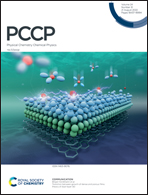Remarkable ferroelectricity-modulated electronic and magnetic properties in a 2H-VS2/BiAlO3(0001) hybrid system†
Abstract
In the present work, a 2H-VS2/BiAlO3(0001) hybrid system is constructed to perform first-principles density functional theory (DFT) calculations. The results reveal that, in addition to the ionic–vdW interface coupling, the ferromagnetic semiconductive 2H-VS2 monolayer on the ferroelectric BiAlO3(0001) substrate exhibits n-type or p-type doping behavior and even half-metal characteristics. Furthermore, the magnetoelectric coefficient (αS) for the 2H-VS2/BiAlO3(0001) structures can reach a value of 10−10 G cm2 V−1 with ferroelectric polarization reversal. The estimated Curie temperatures (Tc) of the 2H-VS2 monolayer on the BiAlO3(0001) Z+ (positive), Z+↓ (polarization-reversed Z+), Z− (negative), and Z−↑ (polarization-reversed Z−) polar surfaces were found to be 176, 276, 266, and 87 K, respectively. This indicates that the magnetic properties of the 2H-VS2 monolayer are remarkably tunable using a ferroelectric BiAlO3(0001) knob. These important findings provide a distinctive treatment option for controllable and adjustable nanoelectronic, photoelectronic, and spintronic devices based on a 2H-VS2 monolayer.



 Please wait while we load your content...
Please wait while we load your content...